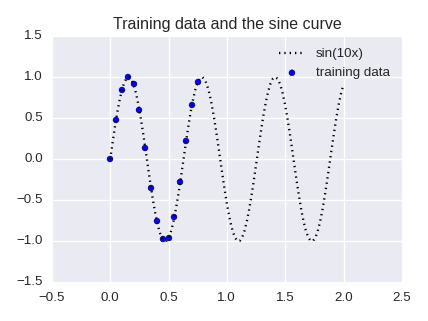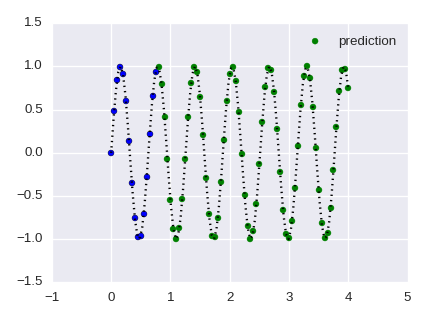I found recently a very interesting blog entry "Neural Nets: Time Series Prediction". The entry is a demonstration of a neural network and the sample code is written in Scala. Because the author does not compare the neural network with other statistical learning algorithms, so I decided to do it. But ...
Problem: recover the sine curve from a small part of it
The values of $\sin(10x)$ are given for $x=0,0.05,0.10,\cdots,0.75$. Predict the values of $\sin(10x)$ for $x=0.80, 0.85,0.90,\cdots$.

The idea is simple: detect a recurrence relation $f$ $$\sin(10(x+3a)) = f( \sin(10(x+2a)), \sin(10(x+a)), \sin(10x) )$$ by using a statistical learning. Here $a=0.05$. Therefore our training data look like the following table.
x-coord x0 x1 x2 y
0 0.15 -2.775558e-16 0.479426 0.841471 0.997495
1 0.20 4.794255e-01 0.841471 0.997495 0.909297
2 0.25 8.414710e-01 0.997495 0.909297 0.598472
3 0.30 9.974950e-01 0.909297 0.598472 0.141120
4 0.35 9.092974e-01 0.598472 0.141120 -0.350783
5 0.40 5.984721e-01 0.141120 -0.350783 -0.756802
6 0.45 1.411200e-01 -0.350783 -0.756802 -0.977530
7 0.50 -3.507832e-01 -0.756802 -0.977530 -0.958924
8 0.55 -7.568025e-01 -0.977530 -0.958924 -0.705540
9 0.60 -9.775301e-01 -0.958924 -0.705540 -0.279415
10 0.65 -9.589243e-01 -0.705540 -0.279415 0.215120
11 0.70 -7.055403e-01 -0.279415 0.215120 0.656987
12 0.75 -2.794155e-01 0.215120 0.656987 0.938000
If we denote by $x$ a value of the x-coord column, x0, x1, x2 and y are $\sin(10(x-3a))$, $\sin(10(x-2a))$, $\sin(10(x-a))$ and $\sin(10x)$ respectively.
import numpy as np
import pandas as pd
''' Prepare the training set '''
step = 0.05
df = pd.DataFrame(np.arange(0.15,0.80,step=0.05), columns=['x-coord'])
df['x0'] = np.sin(10*(df['x-coord']-3*step)) ## sin(x-3*step)
df['x1'] = np.sin(10*(df['x-coord']-2*step)) ## sin(x-2*step)
df['x2'] = np.sin(10*(df['x-coord']-1*step)) ## sin(x-1*step)
df['y'] = np.sin(10*df['x-coord']) ## sin(x) <- target variable
print(df)
We have a very simple training data, so let's make a predictive model. The following image shows the rediction of a certain model which I trained. The prediction is perfect. (The RMSE is 4.61466567015e-15.)

This model is not a neural network
Which statistical learning algorithm did I use? The answer is in the following code.
''' Create a linear regression estimator '''
from sklearn.linear_model import LinearRegression
fit_lr = LinearRegression()
fit_lr.fit(df[['x0','x1','x2']],df['y'])
print('coefficients:', fit_lr.coef_) ## [-0.69092766 0.21269213 1.06423747]
print('intercept :', fit_lr.intercept_) ## 8.32667268469e-17
Yes, this is just a linear regression. No trick. The estimated intercept is almost 0. Therefore we have a very simple recurrence relation:
$$ -0.691 \sin(10x) + 0.213 \sin(10(x+a)) + 1.064 \sin(10(x+2a)) = \sin(10(x+3a))$$
''' Make a prediction '''
yhat = []
x_test = np.arange(0.8,4.05,step=0.05)
X = df.ix[df.shape[0]-1,['x1','x2','y']].as_matrix().reshape((1,3)) ## initial input
for i in range(len(x_test)):
pred = fit_lr.predict(X)[0] ## predict the value of sin(10x)
yhat.append(pred)
X = np.array([[X[0,1],X[0,2],pred]]) ## next input
print('RMSE :', np.sqrt(np.mean((np.sin(10*x_test)-yhat)**2)))
What is happening?
The initial guess could be to make use of $10a=0.5 \sim \pi/6 = 0.52...$. But this approximation is too rough to see the above accurate prediction. In fact we have a rigorous linear recurrence relation.
Remark. In the following discussion we observe $\sin(x+\alpha)$ instead of $\sin(10x+10a)$.
The key observation is the Fourier series expansion of $\sin(x+\alpha)$: $$\sin(x+\alpha) = \frac{e^{i(x+\alpha)}+e^{-i(x+\alpha)}}{2i} = -\frac{e^{-i\alpha}}{2i} e^{-ix}+\frac{e^{i\alpha}}{2i}e^{ix}.$$ Here $i=\sqrt{-1}$. Therefore $\sin(x)$, $\sin(x+\alpha)$, $\sin(x+2\alpha)$, $\sin(x+3\alpha)$ lie all in the complex 2-dimentional vector space spanned by $e^{-ix}$ and $e^{ix}$. (Replace $\alpha$ with $0, 2\alpha, 3\alpha$ in the above formula.) Thus they are linearly dependent (with complex coefficients).
(If you are not familiar with a Fourier series, you may replace two functions $e^{-ix}$ and $e^{ix}$ with two linearly independent vectors $\vec{a}$ and $\vec{b}$. Then you can understand the discussion surprisingly rigorously.)
Put $\sin(x+3\alpha) = \beta_0 \sin(x) + \beta_1\sin(x+\alpha) + \beta_2\sin(x+2\alpha)$ ($\beta_0, \beta_1, \beta_2 \in \mathbb C$). Looking at the coefficients of $e^{-ix}$ and $e^{ix}$, we can easily obtain the following formulas.
$$ \beta_0 = t, \quad \beta_1 = -2t\cos\alpha -1, \quad \beta_2 = t + 2\cos\alpha \quad (t \in \mathbb C).$$
Therefore we have the following formula
$$\sin(x+3\alpha) = t \sin(x) - (2t\cos\alpha +1)\sin(x+\alpha) + (t+2\cos\alpha) \sin(x+2\alpha)$$
which holds for any $t$. (You can directly check that the above formula holds.)
Our training data is enough to find a value of $t$ and the formula explains why the intercept is almost 0. I should also mention that we do not use a specific value of $\alpha$, namely the above formula also holds for any $\alpha$.
Other algorithms?
The linear regression gives an almost perfect analytical approximation, therefore I do not try other algorithms.
Edit [22.03.2016]: I compared a neural network with other algorithms. See the next entry.

